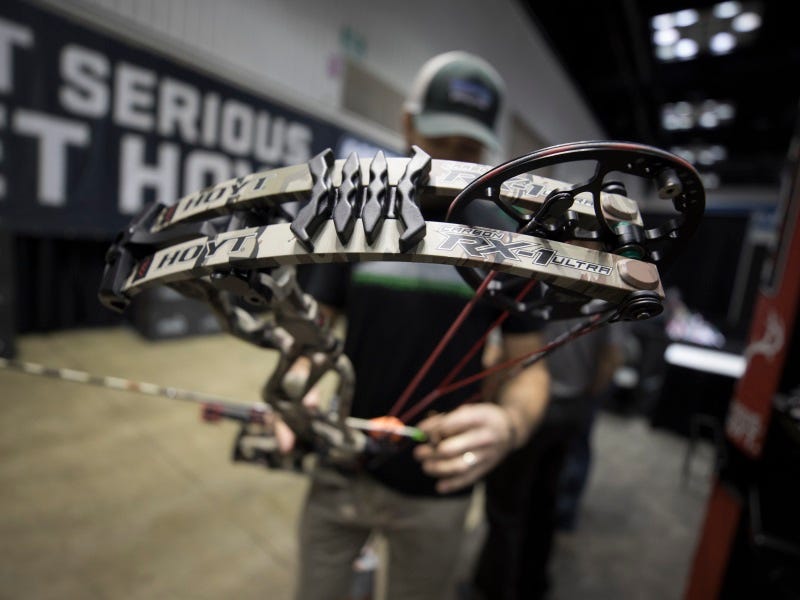10 Days of ATA #5—Hoyt’s New Carbon RX-1 Ultra Bow Shoots Smoother Than The Carbon Defiant


Hoyt 2018 REDWRX Carbon RX-1 Ultra Bow—2018 Archery Trade Association Show
For 2018, Hoyt introduced the REDWRX Carbon RX-1 Ultra Bow. We shot it at the ATA Show in Indianaplis, Indiana a few weeks ago and found it to be a premium bow that is suited for any task, whether that’s in the field or at the target range.
The RX-1 Ultra features a 35-inch axle-to-axle length, a six-inch brace height, and it shoots at 330 feet per second. This bow weighs just 4.1 pounds. The RX-1 Ultra is much smoother on the shot when compared to the 2017 Hoyt Carbon Defiant, and the price comes in at around $1,599. This is a premium bow for any shooter or hunter and it offers draw-weights ranging from 30 to 80 pounds.
Hey everybody. My name is Evan Williams, and we're here at the Hoyt booth at ATA in Indianapolis, 2018. We're here to introduce the new Hoyt Carbon Series Line. This line does come in three different options, so you have a RX 1. It's a 32 axle-to-axle, 6-inch brace height shooting 340 feet per second. This particular one is our turbo model. It's 32 axle-to-axle, 5 7/8-inch brace height at 350 feet per second, and we also have the Carbon RX1 Ultra: 35-inch axle-to-axle, 6-inch brace height, shooting 330 feet per second.
Two new colors we added this year is the Kuiu Verde 2.0 as well as the Sitka Sub Alpine. A couple new things that you're going to see: first off is our new cable system. It's a patent pending system. It works in conjunction with the new ZT Hypercam. The roller system is now an inline, so we've moved the ZT system that has traditionally been our roller system, into our cam with a 3D modeling shift. So what happens is as the cable loads up during the draw cycle, the cable is actually shifted from the outer to the inner position, so there's no cam translation. The entire draw cycle is a vertical cam, so there's no cam lane. There's no need for a moveable cable guard whatsoever.
The other thing that you're going to notice is a new grip, both in mold and style as well as grip location. It's a lower grip geometry, it gives you better tuning, better performance and arrow delivery as well as a new co-molded grip. What it is, is it's the perfect combination between the hunting ergonomic grip we've had in the past and a target grip. So it's thinner through the throat, and it still has the ergonomic cutouts. We've added a real stabilizer mounting location this year. It's still the modular system so each cam family has an adjustable range. The RX1 is going to go from 24 1/2 to 28 in the number two cam. The number three cam's going to cover 27 to 30, and your number three cam is going to cover 28 to 31-inches in a 32-inch axle to axle build.
So, the big shift in carbon technology isn't necessarily the components or how the bow is built, we've went from a hollow carbon tube design to a hollow carbon helical design. So, what that is, is we have three different shapes and sizes through the entire riser, so we were able to layer and change both size of tubing and engineer this riser to specific flex patterns dependent on what cam system we're running, how much speed we're running, what kind of limb and cable system we have on it. So, we can engineer this bow to perform and shoot, tune and everything the way we want it, based on the components that are built with.
With the new grip technology, shifting the geometry, adding the back-bar mount for those guys that want to change the back weight and balance, we still have a shock pod reduction system on a lower, so instead of inline in the head of the riser, we’ve shifted everything to the bottom. What that's done is that's actually created a lower balance weight so the top of the bow is lighter, the bottom of the bow is heavier so when that geometry that grip is shifted, overall bow balance is still near perfect. A lot of traditional bows that have that lower geometry, as soon as you shoot them, they want to roll away. With this one, with lower weight and all that addition that's added in the machining of the lower linpocket, you still get that perfect balance system that Hoyt is known for.
So it's a lot easier ... Again it comes back to tunability and shootability. With a lower grip, you actually get center geometry for your arrow knocking point, so you're exactly between both points of the upper and lower part of the limb, so you get better arrow delivery, better tuning, and it's a lot more "shootable", so it doesn't matter if you have a lot of thumb side pressure, if you have a lot of knuckle into the bow, you can wrap around, it's much more forgiving in the setup of the build.
